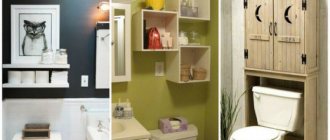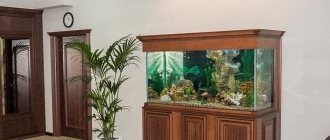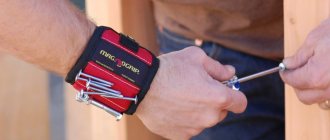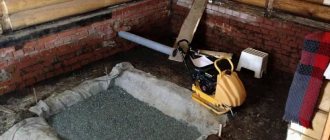Just recently, a hygienic shower in the toilet was a kind of exotic thing. Today it’s hard to surprise with the presence of such plumbing in an apartment. On the contrary, this indicates refinement of taste and the presence of rules of good manners in the house. In addition, using a shower in the toilet instead of a bidet is more convenient.
However, for the average person, such a hygiene item will still be quite new. And you can expect to receive high-quality advice about the nuances of the device and connection options in a plumbing store in rare cases. Therefore, familiarizing yourself with this material will be useful for people who have already decided on the choice of such a device and are just planning to purchase a shower for cleaning the toilet.
Option for a hygienic shower in the toilet Source trendkeramika.ru
What is the device intended for and its strengths
Before connecting a hygienic shower, you should decide whether it is needed at all. In most cases, apartment owners prefer to make do with ordinary bidets, and toilet paper remains the most common method of hygiene in the toilet.
Such a device will certainly be useful in eastern countries or areas where residents profess Islam predominate. It is well known that this religion is quite strict in matters of purity.
The main advantages of installing such a mixer:
- Better cleansing of intimate areas compared to toilet paper.
- A high level of sanitary and hygienic conditions in housing, thanks to the flushing of sewage directly into the toilet.
- There are no possible abrasions and irritations on the skin, as is the case with toilet paper, even the highest quality and most delicate types of which can cause uncomfortable sensations.
- The presence of such a device greatly facilitates household chores associated with cleanliness and sanitation. Using this hose with a nozzle, it is easier to clean the plumbing itself, the children's potty or the cat's litter box.
Hygienic shower as a housekeeping assistant Source amazonaws.com
- Research shows that regular use of a hygienic shower reduces the likelihood of hemorrhoids, proctitis, etc., thanks to the additional massage with a stream of water during the cleaning process.
The main advantage of the device remains its compactness. Its placement is possible in the toilet of any, even the smallest, apartment. The dimensions of such a shower are not much different from a toilet paper holder.
How to assemble, how to install and how to connect a floor-standing bidet to water and sewerage.
How to assemble a bidet?
Before assembling a bidet, you need to know what it consists of and decide what type of floor-standing bidet you have. Simply, floor-standing bidets are divided into two types - simple and complex. They are divided by type of assembly. One differs from the other in terms of configuration - whether the automatic water drain valve is included or not. In the photo below I present to you the bidet assembly diagram. What is connected where, the equipment will be immediately clear, in two types of bidets. This floor-standing bidet assembly diagram can be used as a basis, but remember - your bidet may differ. So don’t throw away the technical data sheet of the product. You will still need it.
How to assemble a bidet, light. scheme.
As you can see, assembling a bidet couldn’t be easier, and assembling it with your own hands is not as difficult as it actually seems. Don’t forget to coat the place where the water is drained, the siphon connection with sealant, and wrap all pipe connections together with fumigation tape.
How to install a floor-standing bidet?
A floor-standing bidet is installed according to the same principle as a toilet. I recommend you read it! Just like a toilet, a floor-standing bidet has two mounting holes in the base that secure it to the floor.
In order to install the bidet we need the following tool:
Hammer or drill;
10mm drill bit for concrete or pen for tiles;
Marker or pencil. (A marker is better than a pencil, since the pencil is constantly erased from the tile).
The mounting bracket for installing the bidet that comes with the kit will have to be replaced with a new one. The one that comes with the kit screws in very poorly. When screwing a screw into a cork, the screw reaches the middle of the cork and simply begins to spin with the cork. We buy a plug and screw for ten, and not for 12, as is included in the kit. I had the feeling that the standard screw was larger than the required dimensions than the plug itself.
Marking, parameters and installation of bidets.
Before installing the bidet on the floor, we need to visually estimate where to place it. It would be easier, of course, to simply place the bidet bowl and move it until we get the result we need. But before you buy, and in principle, the average parameters of the bidet should be taken into account.
Having found the desired location of the bidet, you should use a marker to outline the outline of the bidet sole, as shown in the figure below, and put dots in the places of proposed fastenings. https://www.umnyestroiteli.ru/
After that, remove the bidet from its place and, using a drill or a pen on the tile, according to the given marks, without including the blow, drill holes for installation. The tile will not drill quickly, so don't worry. Having drilled the holes, we insert plugs into them, set the bidet according to our specified mark and boldly insert the mounting screws into the holes for pressing the bidet to the floor. Tighten the screws until the bidet stops swinging on the tile. All! This completes the installation of the bidet. All that remains is to connect the bidet to the sewer and water.
Connecting the bidet to sewerage and water.
To connect bidets to the sewer, rigid hoses are increasingly used, but to simplify your work, you can also connect a corrugated hose to the sewer.
We simply screw the mounting part of the corrugations, not forgetting to coat them with sealant, to the bidet drain, and insert the other side of the corrugations deeper into the sewer outlet and coat the joint with sealant. The sewer outlet should have a diameter of 10. To make it more clear, I am attaching a diagram of the bidet connection to the sewer.
To connect water to the bidet, hot and cold, from the central water supply you need to run pipes of the appropriate diameter and simply twist one with the other. Not forgetting to make a fuss about mom.
https://youtube.com/watch?v=3ft3Jj3vku4
***The article was prepared by the administration of the site Construction from A to Z. Enakievo-Donetsk*.
Design Features
The appearance of the hygienic device is practically no different from the well-known standard shower. Both of them consist of:
- mixer;
- flexible hose;
- watering cans.
But the purpose of the device still causes some differences. There is no need for a large, diffuse stream of water, so select a small-sized mixer with a focused, gentle flow without splashing.
Some models of such showers are equipped with a thermostat to automatically regulate the comfortable temperature of the water stream. Once the thermostat is adjusted immediately after installing the shower, it will ensure that the set temperature is maintained throughout its entire lifespan.
A type of hygienic shower for the toilet Source ozonsanteh.ru
This element will protect you from possible unpleasant sensations when coming into contact with too hot or cold water.
The main difference is that the water from the switched-on hygienic shower does not flow until a special flow control button is pressed, and the pressure is adjusted using a special mixer lever.
Floor bidet connection technology
Connecting a bidet to the sewer is a task of average complexity. But, strictly adhering to the installation technology, even a novice master with only basic repair skills can perform it.
When choosing a place to place the bidet, take into account the availability of free access to the pipes
A floor-standing bidet is installed in close proximity to the toilet. The distance between devices must be at least 70 cm.
Equipment preparation
The first thing you need to do before connecting the bidet to the sewer is to read the instructions supplied with it and check the presence of all components of the structure.
The bowl of the standard model is equipped with three holes: the top one for installing a mixer, on the side inner side for overflow, and at the bottom for direct drainage into the sewer pipe. The drain valve is independent of the device configuration. It is fully automatic.
To connect the bidet to the sewer you will need:
- hammer drill with a set of drills;
- adjustable wrench and wrench;
- Screwdriver Set;
- mounting tape;
- waterproofing tow;
- silicone sealant;
- marker or pencil.
The diagram for connecting the bidet to the sewer, included in the instructions for the device, should be kept at hand at all stages of installation.
Mixer installation
Most models do not include a mixer with the bidet. It should be purchased in advance at points of sale of plumbing equipment.
Installation of an externally mounted faucet involves fixing the device to the outside of the bidet through a special hole
The installation technology is in many ways similar to the procedure for installing a sink faucet.
The procedure is performed in several stages:
- Flexible hoses are fixed in the threaded sockets of the mixer.
- The mixer is installed on the outside of the bowl, tightening it with a nut from below.
- A drain valve is attached in place of the siphon.
- Connect cold and hot water pipes.
- All mating elements are compressed.
When connecting models with internal filling bowls to the sewer system, it should be taken into account that cold water should be supplied to the spout directly from the storage tank located on the rear side. The hot water supply pipe must also be connected independently.
Connection to sewerage
To connect the bidet to the sewer, experts recommend using rigid hoses. But to simplify the task, you can also connect a corrugated pipe to the sewer. It is better to lay out the sewer pipes in such a way that the hose attachment points are located directly behind the plumbing fixtures.
Connection to the system cannot be made without installing a siphon
Bidet siphons differ from their counterparts, designed for connecting sinks and showers, by an elongated drain pipe and a smoother bend of the elbow. This solution allows you to create a larger volume water seal, ensuring uninterrupted operation of the system.
There are also models on sale equipped with several water seals. They are more often used for hidden installation. If open installation is necessary, you can use both tubular and bottle-type siphons.
The technology for installing an open siphon includes the following steps:
- A drain grate is inserted into the drain hole, secured with a nut.
- The receiving part of the siphon is installed on the back side of the neck, securing the structure with mounting nuts.
- A siphon outlet is mounted to the overflow hole.
- The outlet end of the siphon, a corrugated pipe, is inserted deeper into the socket of the sewer system.
The diameter of the sewer outlet must be at least 100 mm
To connect equipment with rising water supply, it is better to invite specialists. Sanitaryware with an internal bowl filling has a more complex configuration. Without knowing the intricacies of installation, it will be difficult for you to connect the bidet to the sewer without making mistakes.
Possible device installation options
Installing a hygienic shower in the toilet has a number of advantages:
- ease of installation and versatility of installation;
- small design;
- versatility in use;
- low cost;
- comfort in use.
The design of the “hygienic shower” concept is possible in four different external and functional options.
In the form of a shower toilet
This equipment has a special design with nozzles built into the body, which are hidden under the rim when the bidet function is turned off. The control of the device is built into the drain tank, increasing its dimensions. This way you can adjust the power and temperature of the flow, but the direction of the jet does not change by adjustment.
Toilet combined with bidet Source vvannoi.ru
This type of plumbing fixture is produced in floor-mounted and wall-hung versions, can be mechanical or electronic, and is constantly being improved by manufacturers. Therefore, the functionality of the device directly depends on the manufacturer and cost.
In the form of a bidet lid for the toilet
A fairly compact and convenient option that can be easily mounted to an old toilet model. In essence, this is a standard toilet lid of a special design containing a fitting for water supply. The control of the device is built directly into the lid, as a rule, it is capable of heating water, drying and gently lowering the seat.
The weak point of the design is the external water supply using flexible hoses. Often this does not look very aesthetically pleasing.
There are even fully electronic bidet lid options from well-known brands. The functionality and comfort of such elite sanitary ware differs significantly from conventional models, as does the price.
Electronic bidet lid for toilet Source insales.ru
See also: Catalog of companies that specialize in the design and installation of engineering systems.
In the form of a shower mounted on the wall
Arranging a hygienic shower in this way is the most common and convenient. Installation is carried out directly to the pipeline, and the compact watering can is placed on a long flexible hose on the wall. This will require certain construction work.
According to the standard, the height of a hygienic shower from the floor should be 60-80 cm, and the length of the hose should be limited to 1.5 meters. It is not recommended that it touch the floor.
As a rule, this version of the mixer is not equipped with a thermostat. However, it will not be difficult for a competent plumber to install this unit directly near the water supply in an inaccessible place. This will not affect ease of use, because... It is enough to adjust the thermostat once and for the entire service life.
The installation height of the hygienic shower and the distance from the toilet should be set so that using the device does not require additional effort and acrobatic abilities.
Hygienic shower on the wall Source wixstatic.com
In the form of a shower connected to the sink
This option is suitable for combined bathrooms, where there is a sink located near the toilet. You will need to purchase a special mixer with three outlets.
In the case of a separate bathroom, it will be enough to install a small sink in the corner of the room.
If the sink is already standing, then this option will be the most profitable financially and the least labor-intensive. Adjusting the water temperature is also easy in manual mode and does not require additional costs.
Installing a small sink with a hygienic shower in the toilet Source kitchenremont.ru
Combined with toilet
If the size of the bathroom does not allow you to connect a hygienic device, you can buy a toilet combined with a shower, or purchase a bidet lid.
Related article: Table setting for the New Year
A special nozzle is built into the side of the shower toilet, and an electronically controlled device is installed into the tank.
The nozzle extends when necessary without touching the walls of the bowl. It also cleans itself before starting work and afterward under water pressure for a few seconds. Water is supplied using buttons mounted on the outside of the bowl. It is very rare to supply water using pedals.
The functions of a bidet toilet are the same as those of a regular bidet: blowing, heating.
If you do not plan to replace the toilet, install a bidet cover. It is the easiest to install. It is enough to connect it to the water supply and electricity, and then attach it to the toilet, like a regular lid, according to the instructions.
When the siphon and mixer are assembled, the bidet itself is connected.
It is installed in the same way as a regular toilet. The plumbing fixture is placed in the required location, markings are made, holes are drilled with a drill, then bolted. Finally, water supply and sewerage are connected.
Installation methods
Installation of a hygienic shower can be carried out in two ways - external and built-in.
Outer
The external method includes the above-described connection options to a conventional wall-mounted washbasin or bathtub faucet.
The advantages of this method will be the ability to install a mixer with a thermostat or simply adjust the temperature using the mixer lever above the sink. This is often much more convenient than controls installed above the toilet, on its lid or tank.
Built-in
This method involves hiding all communications and mechanisms behind the wall, bringing out only the platform with the lever. A mount for a watering can is also mounted outside. Sometimes it is already located on a common platform. Each option has a very aesthetic and presentable appearance.
Operating principle, advantages and disadvantages
Modern manufacturers produce a wide range of products of this type. Their models differ in cost, appearance and functionality. What they have in common is the purpose of plumbing fixtures. In Turkey, Japan and Korea, bidet covers are commonly installed in public toilets.
Expert opinion
Koklyaev Vladimir Stepanovich
Experienced plumber with 12 years of experience
In appearance, the products resemble ordinary toilet lids. Their design is equipped with two retractable nozzles. They are used to connect to the toilet cistern. When you press the button, water begins to flow through the nozzles. Modern bidet lids have electronic controls that automatically regulate the pressure and temperature of the liquid.
Advantages:
- compactness;
- ease of operation and installation;
- hygienic comfort.
Main disadvantage:
- Certain skills in handling the device are required.
Video description
The process of installing a built-in hygienic shower can be viewed here:
This method is more problematic and has many disadvantages:
- the possibility of installation is not always possible and is determined by the presence of ventilation shafts, the thickness of the walls, etc.;
- control of water shutoff is difficult (if the water supply is not shut off, it can lead to a leak);
- there is a possibility of heated water mixing with cold water (this will affect not only the owner of the shower, the neighbors will also feel it). It is recommended to purchase a device containing a built-in check valve or install such a valve separately;
- there are no built-in models with thermostat adjustment on the platform (the temperature control device is usually adjusted once and hidden behind the wall);
- In the absence of a thermostat, the water temperature control is located above the toilet. This means you need to choose the right toilet model, which has an elongated bowl shape.
What types of bidets are there?
A bidet is a sanitary ware designed for personal hygiene. Externally, the device is very similar to a regular toilet, but technically it is a low-hanging washbasin.
It is also connected to the sewer, but instead of a tank there is a faucet or fountain. There are floor-standing bidet models and a hanging version. The first ones are mounted on the floor, and the second ones are hung on the wall.
When choosing a bidet, you should take into account not only the method of its installation, but also other design features. For example, the mixer can be either a regular two-valve or a single lever with a ball mechanism. The latter is considered more convenient.
A bidet is a small personal hygiene device that can be extremely convenient for sick and elderly family members.
The spout is designed in such a way that the water stream can be directed upward at a suitable angle. In some models there is no spout at all; water flows from the bottom of the bowl like a small fountain, the direction of which can also be adjusted. The design of the product should be chosen in accordance with the style of the plumbing that is already in the bathroom.
There are retro models of modern bidets, and products made in the trendy high-tech style
It is equally important to take into account the size of the plumbing fixture, especially if we are talking about a small bathroom. There should be some space around the bidet so that it is convenient for the bathroom visitor to use it.
Wall-mounted bidet models are compact in size and make cleaning the bathroom easier. The toilet and bidet, made in the same style, look very impressive
Wall-mounted models look very compact, but to install them you should use a special installation, which should be placed in a niche behind the bowl, or behind a special false panel. To accurately take into account all these points, you should carefully measure with a tape measure both the space intended for installing the bidet and the device itself.
An excellent alternative to free-standing bidets is an intelligent toilet, which practically combines the functions of both types of plumbing fixtures in one housing:
Video description
The specifics and advantages of hygienic shower options can be seen in this video:
To summarize, a person will need to do:
- marking walls;
- gating;
- pipe laying;
- installation of communications, adapters, valves;
- facing works of new walls;
- connecting the mixer and hose;
- holder fastening;
- adjusting the thermostat, if equipped.
The lack of experience in carrying out at least one of these types of work suggests that it is better to contact a specialist with installation questions. Improperly carried out work can lead to a water breakthrough, flooding of neighbors, and, as a result, compensation for the damage caused.
Pros and cons compared to bidets
There is no need to argue about what is more convenient - a pair of toilet + bidet or a hygienic shower for the toilet. Everyone decides for themselves. Let's take a quick look at the main pros and cons of both devices:
- To install two bowls - a bidet and a toilet - more space is required. You can’t argue with this argument, although not everyone has a need to save space.
- When performing intimate hygiene procedures using a hose and watering can, you do not need to move from one plumbing fixture to another. Also an obvious fact.
- When using a shower, it is mounted somewhere on the wall. At the end of use, it may “drip” for some time - the remaining water will drain out. This is mainly a theoretical possibility, since in practice, with a properly functioning switch, there are no wet spots under the watering can.
Nobody bothers you to put all the options
- When using a bidet, it is very difficult to forget to turn off the water. If you have a wall-mounted version of a hygienic shower, this is easy to do: there is a double shut-off system - a button/lever on the watering can and a tap on the mixer. The tap should not be left open after the procedure. In this case, the flexible hose is under constant pressure, but it is not designed for this, so it can break. The situation is different when using a faucet on a sink - you can see that water is flowing.
- A flexible hose can be used not only for its intended purpose, but also for other needs. For example, it is convenient to draw water, wash the toilet or cat/dog bowls and trays.
Oddly enough, it is the last fact that is often decisive - an additional bonus in the form of expanded functionality is always pleasant. Another advantage of showers is the possibility of organizing them for relatively little money. But this is about devices with a mixer.
Video description
Installation of a hygienic shower in a toilet with polypropylene soldering:
First you need to turn off the water supply and make pipe routing, preferably with the least number of turns.
If you have a thermostat, you should carefully approach the issue of connecting the water so as not to confuse the cold and hot pipes. The first is usually located on the right, and the second on the left. Then you should install pipes under the mixer, matching the distance with the holes of the mixer and thermostat.
After this, the wall is walled up and plastered, and then a hose with a mixer is connected. The nuts should be tightened as tightly as possible, but without over-tightening.
It is recommended to use anchor bolts to secure the holder to the wall. You should start by drilling holes for the dowel. A hole depth of 6 cm with a diameter of 6 mm will be sufficient. Then you need to insert the dowels and secure the clamp with anchors. The height of the hygienic shower from the floor should be as convenient as possible for its use by the shortest member of the family. This method is simple and reliable.
An example of placing a hygienic shower with size markings Source pinimg.com
After completing the installation, you should configure and check the operation of the hygienic shower. The pressure is turned on and the product is checked for leaks. A comfortable water temperature is checked and adjusted, and then its supply is shut off. It is recommended to turn off the water supply to the faucet after using the shower to reduce the effect of pressure on the control valve.
Suspended
The built-in bidet has its advantages:
- Hidden communication that cannot spoil the design of the bathroom with its appearance.
- Saving room space. The bidet bowl does not protrude as much, which saves some space. This is an excellent option for small spaces.
- Easy to clean the room, since this plumbing fixture does not rest on the floor.
- And, of course, easy installation.
A hanging bidet consists of a supporting frame and a bowl. The installation serves as a support for the bowl and also as a place for installing the bidet. It allows you to accurately adjust the height of the plumbing fixture.
The technology for installing a hanging bidet is as follows:
- prepare a niche for installation. To do this, a recess is made in the wall according to the dimensions of the supporting frame;
- install water supply and sewerage systems;
- install the installation by attaching the lower legs to the floor and the upper fasteners to the wall;
- connect the installation outlet to the sewer, secure the water supply to the strip and screw the studs into the supporting frame. The bowl will be mounted on the studs;
- sew up the niche with plasterboard;
- Attach the bowl and connect the bidet to the water and sewer pipes. Be sure to place the rubber or silicone gasket included in the kit between the wall and the bowl. It will become a buffer that will protect the wall and bowl from destruction, and also compensate for the load on the installation studs;
- secure the bidet by tightening the nuts.
Article on the topic: Stucco molding on the facades of houses, a lightweight version of heavy decor
If the rubber lining is not included, you can make it yourself. Take regular silicone in tubes and apply it around the perimeter of the bowl. Once the silicone has dried, you can attach the bidet.
There are some nuances to tightening a nut. If you tighten it too much, the drywall will bend, and if you don't tighten it enough, the bidet will wobble. The main thing here is to find a middle ground.
Video description
You can watch this video about whether you need a hygienic shower and what to look for when choosing one:
When choosing a device, you must pay attention to the material of manufacture. The ideal option would be chrome-plated brass or stainless steel with ceramic inside. Bronze products will be more expensive. But silumin ones are cheap, but not reliable. It is best to purchase products with a quality guarantee. Their selection is very large, and prices generally range from 1 to 15 thousand rubles.
Assembling the siphon
Like the faucet, the siphon is sold separately. It has different models and connection technologies, so consult the seller when choosing a siphon. Any model is easy to install and has a long service life. Siphons for bidets are produced from plastic, brass and stainless steel.
The siphon is installed like this:
- install a drain grate with a rubber pad;
- secure the grille with a wedge-shaped ring nut;
- Lubricate the outlet pipe ring with sealant and insert it all the way inside the waste pipe socket;
- check the connection for leaks;
- connect the siphon to the outlet pipe and screw it with a nut.
When making connections, use tow or plumbing flax. The tow is wound onto the thread strictly in its direction, in this case the wound threads will not fluff.
Manufacturers of the best showers for bathrooms
There are quite a lot of products for this purpose in stores and it is very difficult to figure out which one is better. Therefore, professionals recommend giving preference to products from world-famous companies. There are not so many such manufacturers. Based on user reviews and product popularity, the most popular brands are listed below:
- Hansgrohe;
- Damixa;
- Grohe;
- Geberit.
Hygienic shower set TM Grohe Source kaplya.com.ua
Products from these manufacturers will be guaranteed to be of high quality and comfortable, however, the cost of such faucets will be appropriate. But many experts are sure that saving in such a matter is inappropriate. Purchasing a cheaper and lower quality device, as a rule, leads to its faster breakdown and forced costs for its replacement and payment for related work. Therefore, the quality of the purchased plumbing fixtures should directly depend on the complexity of the installation work being carried out. It will be quite expensive to replace a leaky gasket or broken thread when the product is installed built-in.
In order not to become a victim of deception and not to purchase counterfeit goods, it is recommended to purchase plumbing fixtures in salons with a good reputation and with the obligatory presence of the necessary quality certificates for the products offered.
It must be remembered that high-quality products are not made from cheap materials, and their price will be appropriate.
Mixer for bidet with hygienic shower Source sanusel.ru
Types of toilet installations
Today, there are 2 types of installations that have their own design features.
Block structures
They are mounted only on main walls and consist of a plastic tank with fittings. A set of fastenings is additionally included with the toilet. This type of installation for toilets is installed in a pre-prepared niche and is completely hidden in the wall. The main advantage of this design is accessibility, but if there are no solid walls in the bathroom, then installation is impossible.
After purchasing a toilet, many decide to install it themselves. The procedure is very simple and does not require special skills. Increasingly, people are buying in order to save space; there is an additional design - an installation, which ensures that the toilet is attached to the wall. In such cases, installing a toilet installation yourself can raise a number of questions. To provide a complete picture of the work process itself, there is a special toilet installation instruction that will help in acquiring all the necessary knowledge.
Let's take a closer look at the entire sequence of work that must be done when installing a wall-hung toilet.
Before starting work, you need to check that you have all the tools that may be needed during the work process. This is a tape measure, a pencil or marker, a hammer drill with drills for concrete, a building level, spanners and open-end wrenches.
Now you should unpack the box with fasteners and see if everything is available. Manufacturers try to complete their products as much as possible so that a person does not have to buy additional fasteners. Therefore, it is enough to compare the equipment available with the one specified in the instructions. Let’s begin the work process.
The first step is to start applying markings that will indicate the mounting location. The location of the sewer drains must be taken into account to ensure the installation procedure is as simple as possible. Typically, the installation system should be located at a distance of 14 mm from the wall.
Now you should mark the attachment points of the cistern; usually it is located at a height of 1 meter from the floor level. It is also necessary to mark the mounting points of the installation elements on the wall and floor. After applying the markings, you need to use a hammer drill to make holes in the wall and floor where the installation fasteners will be located, and insert dowels into the holes. Regardless of the type and features of the installation, it will require horizontal and vertical fastening. It is necessary to install mounting anchors into the holes with installed dowels; with their help, the installation will be attached to a vertical plane
When installing, it is important to follow the sequence so that in the future there is no need to adjust the vertical level. Now you can install the installation structure itself, attach it to the levels
It is very important to install the housing in a level position relative to the vertical and horizontal levels. Only after the installation is installed correctly can all fasteners and bolts be tightened, firmly fixing the structure. Now comes the stage at which the sewerage system is connected to the installation and secured. The design is initially equipped with special plastic clamps, this will significantly facilitate the work and speed up its implementation.
After all the work is completed, you need to once again make sure that the installation is securely fastened, that the bolts are properly tightened, and that the structure complies with the levels. At this stage of control, you should be extremely careful; any inaccuracy or poor fixation of the structure can lead to breakdown in the future.
Briefly about the main thing
A hygienic shower is one of the most convenient ways to carry out post-toilet procedures.
- Small in size. It can be placed even in the smallest closet without harming the free space.
- In addition to its direct purpose, it is often used for other household needs.
- The choice of a hygienic shower model is purely individual and depends on the size, layout and design of the toilet room.
- As with other plumbing equipment, it is recommended to purchase only high-quality certified products.
- It is recommended to entrust the installation of this plumbing fixture to a trained specialist, because... errors during installation can lead to big troubles for you and your neighbors. This is especially true for hidden devices.
Installing a floor drain
As mentioned above, the bidet faucet is mounted like on a sink, and the sewerage system is connected like the toilet that has long been familiar to us. And the recommended floor drain is done the same way as for a shower stall.
The purpose of the drain is to remove water from the floor, prevent dampness and mold formation. It is recommended to do the construction during the renovation of the entire floor in the room, since waterproofing and screeding work will be necessary.
When installing a drain, a special drain made of brass, steel or plastic is used, which is connected to the sewer. The drain must be durable and resistant to corrosion.
To begin work, remove a small section of the floor and then lay the waterproofing. Connect the water drainage pipe to the sewer outlet and check the tightness.
Place a thermal insulation layer on top, such as polystyrene foam, and fill with cement mixture.
Make sure that the drain funnel fits tightly to the floor. When the cement has dried, you can begin finishing work.
We can sum it up. When connecting a bidet, take into account the type of structure and location of the sewer system. Buy a plumbing fixture with instructions in clear language and follow them strictly. If the bathroom is not large, use bidet covers or shower toilets. Make a drain in the floor, the water will drain, preventing dampness in the room.
Choosing a bidet for the bathroom
Before purchasing a plumbing item, you need to understand which model to purchase. For a small bathroom, a wall-hung configuration is best. And the floor structure is recommended for use in more spacious rooms.
It is better to install the mixer in cases where water is supplied to the bidet from a tank or other reservoir. To supply from the water supply, two taps should be installed: cold and hot water.
Installation is more difficult to do and it is better to entrust the installation to a specialist who will make the correct connection to the sewer. And upflow models are complicated because they not only have a drain valve, but also a mixer valve. Here the water passes under the rim of the seat, heating it, and then is supplied upward by a fountain.
The fountain hole is located at the bottom of the bidet; soapy water from washing flows here, but it is not absorbed and does not spoil the clean water in the supply system.
- It is better to buy a toilet and a bidet at the same time: pick up these two items from the same series from the manufacturer. They will be styled the same and will also fit well;
- If a bidet is purchased late, then you need to select it in advance from the manufacturer’s line, remember its model and article number;
- Remember that with floor-mounted plumbing the pipes and all communications are open, while with wall-mounted plumbing they are sewn into a niche;
- Many people prefer earthenware and porcelain plumbing fixtures, but porcelain is much easier to care for.
How to choose?
There is no strictly defined standard for the dimensions of installation frames. In each specific case, the choice is made taking into account the dimensions and design features of the toilet room. If you have enough free space, you can think about installing larger structures, including even a bidet.
If there is a solid wall in the room, it is worth considering block models of installation frames. It is often necessary to equip a non-standard room in limited space. In such cases, experts recommend studying the dimensions of corner structures.
It turns out that choosing a box for subsequent installation of plumbing must take into account not only personal preferences. In this case, we are also talking about the installation and connection features of all products. So, for example, the installation dimensions for a built-in toilet are selected taking into account the distance from the bowl to the wall or pieces of furniture. This value must be at least 60 cm, otherwise using the toilet will be uncomfortable, since your feet will rest against the mentioned obstacles.
Standard systems are suitable for equipping larger rooms. In such cases, the bowl is installed 18-20 cm from the box. And it is recommended to maintain the distance mentioned above on all sides of the plumbing fixture.
Before purchasing and starting installation, you should carefully study the plan of the toilet or bathroom. This will allow you to choose the most convenient and most suitable place for the plumbing and its dimensions
It is worth paying special attention to the following points
- With standard installation of the frame near the walls of the toilet room, you can choose both block and frame models. Their sizes are selected taking into account the dimensions of the plumbing and the room.
- If you need to install a plumbing system in a small room, in the attic or under a window, then you should consider small-sized models. Their height should not exceed 85 cm.
- For installation of plumbing fixtures on both sides of the duct, installations with appropriate fasteners (double-sided) and dimensions are provided.
- When equipping premises in which it is necessary to install several wall-hung toilets at once, special installations are chosen. We are talking about linear structures with a height of 115 cm.
The vast majority of frames are rectangular in shape. At the same time, they should be selected taking into account the commensurability of the parameters of the product itself and the niche. In cases where the box is larger, the voids are usually filled with materials that have soundproofing properties.
The standard dimensions of built-in toilet models are as follows:
- height – from 35 to 45 cm;
- depth – from 50 to 60 cm;
- width – from 30 to 40 cm.
Although the parameters given are standard, they may vary.
It should be remembered that now manufacturing companies offer more than a wide range of models. We can talk about special children's toilets, as well as products with enlarged bowls. In addition, plumbing fixtures are produced for people with disabilities and heavy weight. Naturally, all these factors will determine the choice of installation structures and their dimensions.
In addition to all of the above, you should take into account the size of the cistern. In the vast majority of cases, the thickness of hanging plastic devices is 9.5 cm and their width is 0.5 m
The height of such tanks, as a rule, is slightly higher than the similar parameters of conventional models. This size varies from 55 to 60 cm.
When choosing a frame for installing built-in plumbing, you need to remember the design features of various types of systems. Thus, frame options have a depth of 15-30 cm (more often we are talking about the minimum parameter). The height of such models can be from 85 to 140 cm, and their maximum width is 60 cm.
The following dimensions must also be taken into account:
- the center of the sewer pipe is located 22 cm from the level of the floor covering;
- The distance between mounting holes is 18 to 23 cm.
The minimum dimensions of block installations are, as a rule, identical to the similar parameters of frame structures. Their depth can be from 10 to 15 cm, and their height can be up to 1 meter. It is also necessary to consider the possibility of separate installation of the built-in cistern and toilet bowl. The latter in such cases is not attached to a niche, but directly to the wall.
For more information about the installation for the toilet, see the video below.
Which hygienic shower to choose
There is a huge selection of hygienic toilet showers that can be used instead of a bidet. They differ in designs, manufacturers, and equipment. Accordingly, the spread in their price levels is very large. But you can always find something to suit your wallet. You can get by with a very inexpensive kit. I will now share my experience, which path we took and what we chose as a result.
We started choosing from a hygienic shower head , since it is the key element of this sanitary design, and all ease of use depends on it. As I already wrote, all these watering cans are equipped with special buttons that need to be pressed and held with your finger. It seemed to us that this might not be very convenient, but we found a watering can in which this button has the ability to be fixed .
The sequence of actions is as follows:
- fix the button on the watering can
- open the water in the mixer
- do hygiene procedures
- turn off the water in the mixer
- remove the clamp from the watering can
- insert the watering can into the holder
In this short video I show how I do it.
It’s very convenient - you don’t need to hold the button with your finger while taking hygiene procedures.
If it is useful to anyone, the name of the company that produces such hygienic watering cans with a lock is Gro welle, model APF 932. We bought it for 490 rubles. The kit includes the watering can itself and a holder for it. The watering can provides a standard hose mount.
Since we bought the watering can separately, we also had to buy the mixer . We had the following requirements:
- faucet for shower only (that is, without spout);
- so that it is of high quality;
- with cartridge;
- so that the handle with which the water is regulated is located in a horizontal plane when closed (with our design this is more convenient).
As a result, the choice fell on the German Wasserkraft Oder 6302 mixer for 3,000 rubles. We simply connected our hygienic shower head to the hose of this mixer instead of a standard watering can.
This is the set we got. Everything has been tested, is convenient and works properly. That’s why I decided to share my own experience in such detail. You can also go the other way. Firstly, if desired, the components can be purchased either cheaper or more expensive. And, secondly, you can buy everything at once in one set.
Well, now you know that if there is no place for a bidet in the toilet, it’s not a problem at all! A hygienic toilet shower can perfectly replace it! Using a shower instead of a bidet is no worse, and in some ways even better!
I'd love to hear your feedback on the idea of using a toilet shower instead of a bidet. Have you already encountered such a device, what can you say about it? Did you like this idea? I'm waiting for your comments!
Previously, I already introduced you to my own experience of how we updated our kitchen set at minimal cost . Perhaps this experience will be useful to you too. Read here.
You can find other interesting ideas, useful tips and recipes for the whole family on the site map.
Author of the blog “Note to the Family” Ksenia Druzhkova
How to choose bidet lids for toilets
Before purchasing the product, the toilet is measured.
For these purposes, 4 distances are measured:
- from the drain barrel to the mounting holes;
- from the mounting holes to the end of the toilet;
- from hole to hole;
- from the tank to the edge of the toilet.
The remaining characteristics of the products that you should pay attention to depend on the financial capabilities and taste preferences of the buyer.











